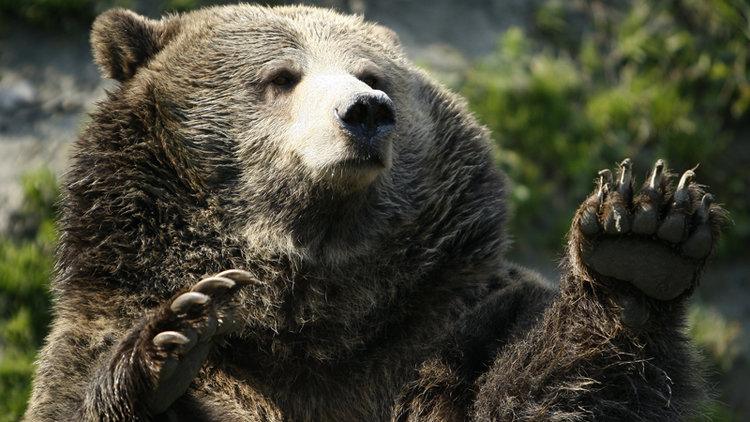Navy SEAL explains how to survive a bear attack

In this excerpt from 100 Deadly Skills: Survival Edition, retired Navy SEAL Clint Emerson explains how to survive a bear attack.
If you run into a black bear on a mountain trail, be grateful for your good fortune. Compared to polar bears and brown bears, black bears are much less likely to attack.
Brown bears (sometimes also known as grizzly bears) are the most aggressive species of bear, while polar bears are always hungry—and unlike black and brown bears, polar bears will actively track and hunt down humans across their arctic terrain. Their massive height and heft make them formidable opponents, capable of disemboweling prey with a single swipe of their claws.
Human-bear interactions have become increasingly frequent as various regulations and conservation efforts have swelled the bear population across North America, with black bear sightings particularly on the rise. Fortunately, bear attacks are very rare in general—you have a 1 in 2.1 million chance of being mauled, which means that almost any routine daily activity has a greater chance of killing you.
But activities such as bow-hunting for elk in the mountains of Montana or backpacking in the Yellowstone range will significantly increase your risk of a lethal attack. And there’s no discounting the occasional suburban visitor who rifles through Dumpsters or even locks himself inside the family sedan.
Commonsense Precautions
The number one reason for bear attacks? Humans getting too close for comfort. Give bears an extremely wide berth, and never get between a female bear and her cubs. If you spot a bear from a distance, change your route. Stay quiet, so as not to pique the bear’s interest. Should a change in direction be impossible, do not proceed until the bear has been out of sight for thirty minutes.If you’ve spotted bears in the vicinity, clap your hands and use your voice to emit a steady stream of noise as you transit. Bears have a formidable sense of smell, so when you’re stopped for the night, follow the commonsense strategies of double-bagging and hanging your food.
Place food, cookware, and utensils at least one hundred feet from your tent, and never set up camp near bear scat or tracks. Store any scented products (toothpaste, soap) with food and cooking supplies. Do not sleep in the same clothing you cooked in, as food scents may remain on fibers.
Transit through bear country with two or more companions if possible—bears don’t tend to attack groups.
Carry bear spray (a form of pepper spray), which has been shown to be more effective than handguns at deterring bear attacks, and a whistle. Grizzly bears are currently protected as a threatened species in the lower forty-eight states, so killing one will result in a federal investigation complete with forensic analysis.
If the bear is close and has spotted you, get big. Wave your arms around and make noise. Often this strategy will make bears stop in their tracks and run off.
When Bears Attack
If the bear charges you, this is the moment to use bear spray or shoot. Dispense bear spray when the bear is within forty feet, or aim rifle sights at a spot below its chin, or just behind its front legs if shooting broadside. If you are unarmed, stand very still. The bear may be doing a false charge to test your mettle as a potential predator, and could lose interest once it sees that you are not a threat.
If the bear attacks, most experts agree that this is the moment to lie down and play dead. You want to convince the bear that it has done its job and effectively minimized the perceived threat you posed. Lay flat on your stomach to protect your organs, crossing your hands behind your neck to guard your arteries. Or curl into the fetal position, covering the back of your neck with your hands.

Playing dead is an effective strategy with a 75 percent success rate; because most bear attacks are defensive in nature, bears will back down once they recognize that you are not a threat. Of course, nothing is predictable in the wild. Bears, though omnivorous, subsist mostly on plants and fish—but they have been known to feast on human flesh.
Never turn your back on a bear, and never try to run. Both of these actions can kick-start a bear’s predatory reflexes—and you’ll never be able to outrun a bear, as the animals can travel at up to thirty miles per hour. Instead, slowly walk away sideways, keeping an eye on the animal so that you can monitor its movements.
If playing dead does not cause the bear to lose interest, you are the rare victim of a predatory attack. The bear intends to kill and possibly eat you, so fight back with any available weapons—a knife, sticks, rocks, your fists. Aim for the eyes and nose, where the bear is most sensitive.
There’s no tried-and-true, written-in-stone protocol for handling a bear attack, in part because attacks are so rare. So it’s no surprise to find debate among bear-country dwellers about how to handle a grizzly charge versus an encounter with a black bear. Some say that playing dead is more likely to work with the former, claiming that the latter’s less frequent attacks are more likely to be offensive.
But all agree that pepper spray is the single best deterrent, one so effective that it has been used successfully by children under the age of ten.


nockedup Massachusetts outdoors.